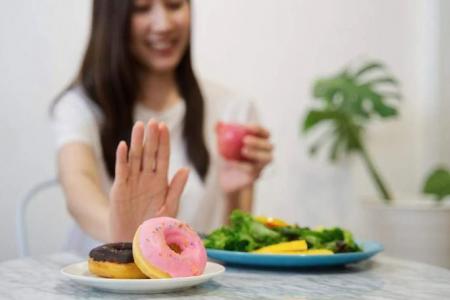10 ways to cut sugar from your diet
The news on sugar is far from sweet. One in three people here is at risk of developing diabetes in his or her lifetime. If nothing is done, by 2050, it is estimated that about one million Singaporeans will be living with diabetes.
In a bid to reduce the sugar intake here, food and beverage outlets will be required by the end of 2023 to include nutrition labels indicating drinks that contain higher levels of sugar and saturated fat.
In 2016, the World Health Organisation called on countries to take action to reduce individuals’ intake of sugar to as low as possible, stating that “nutritionally, people do not need any sugar in their diet”.
According to the National Nutrition Survey 2018, Singaporeans are consuming on average 12 teaspoons, or 60g, of sugar daily. This is higher than the recommended daily limit of no more than 10 per cent of one’s daily energy intake, which translates to about 10 teaspoons or 50g of sugar a day for adults.
For some, food and beverages laden with sugar can be quite addictive.
Ms Shirlene Moh, a senior dietitian at Changi General Hospital, says that when a person is accustomed to a certain level of sweetness for the food and drinks he or she consumes, the person will crave sweeter foods.
“As sugar tricks the brain into wanting more of it, one may end up consuming more sugar. When that becomes a habit, cutting back on sugar intake can then be challenging,” she says.
Here are 10 ways to help you cut down on sugar in your diet.
1. Know your enemy
Take a look at your fridge and pantry, and identify the food and drinks that are contributing to your added sugar intake, says Ms Adlyn Farizah, an accredited nutritionist at The Whole Kitchen, a gluten-free bakery with outlets in East Coast and Robinsons Road.
“Note it down if you are having them often. This helps you to be more aware of your added sugar intake so you can make the necessary changes,” she adds.
For instance, if you have jams and juices in your fridge, replace them with lower- or no-sugar alternatives.
2. Be a champion reader
Ms Moh of CGH advises looking out for the Health Promotion Board (HPB) “Lower in Sugar” healthier choice symbol as it indicates that the product meets the agency’s strict nutritional guidelines.
She also suggests scrutinising the nutrition label when buying food or beverages off the shelf and comparing the sugar content between two products using the per 100g column. Choose the one with a lower sugar content.
3. Master of disguise
The next time you go grocery shopping, take some time to read the ingredients list and nutrition panel of packaged food and drinks.
Ms Adlyn says one should look out for the alternative names of sugar. The ones commonly used include sucrose, dextrose, nectar and syrup. “Such added sugars from beverages or packaged foods are often heavily processed and provide no additional nutritive value.”
4. Be wary of gravy
A plate of mee siam could contain up to 10 teaspoons’ worth of sugar, warns Ms Moh. Besides reducing the amount of gravy in dishes, try to prepare more home-cooked meals, where you can be in control of the amount of sugar that goes into a dish.
Dr Naras Lapsys, a consultant dietitian at The Integrative Medical Centre, suggests: “Bring out the recipe book or search for healthy recipes and prepare a few more meals each week. Learn how to cook from scratch so that you use less store-bought sauces and packaged food, which are often heavily sweetened with excess sugar.”
5. Spice things up with herbs
When you prepare your food, experiment with flavours other than sweet.
Says Ms Adlyn: “There are a variety of herbs and spices that you can use to add more flavour and depth to increase palatability rather than adding sugar. These include lemongrass, oregano, cinnamon and cumin.”
6. Use fruit instead of sugar
If you must use sugar, try using natural sources such as fresh or dried fruit, or honey in moderate amounts, she advises.
These alternatives, Ms Adlyn says, provide nutrients such as vitamins, antioxidants and fibre. In particular, the fibre in fruit helps to slow down the digestion and absorption of sugar in the body compared with standard white sugar. “The benefit is you don’t get an energy spike or energy crash. It keeps your energy levels more stable throughout the day,” she adds.
7. Swop out soda for kombucha
More than half of Singaporeans’ daily sugar intake comes from beverages, of which pre-packed ones contribute 64 per cent. Dr Lapsys suggests replacing sodas and sweet drinks with water and mineral water infused with fruit, or with lemon or lime wedges.
Kombucha, a fermented black or green tea drink, is a healthy thirst quencher too. “These drinks have become popular, are often very low in sugar, refreshing and come in a variety of flavours such as passion fruit and apple,” he says.
8. Think twice before stirring in more sugar
If you tend to add sugar to the drinks and food you prepare on your own, such as coffee, tea and oatmeal, a good place to start is to gradually reduce the amount until your taste buds get accustomed to the taste, says Ms Adlyn.
“Adjust the sugar levels or portion size, or reduce the frequency of the sugary drink or snack you consume,” she suggests. For example, if it is a habit for you to drink tea with three teaspoons of sugar, reduce it to one and a half. If you drink tea with sugar three times a week, cut down to twice a week.
Ms Moh also recommends to bubble tea lovers that they opt for “zero per cent sugar” and avoid adding pearls to the beverage.
9. Stop the spread
Many breads and pastries are highly processed and full of sugar, notes Dr Lapsys. This includes white bread, cinnamon rolls and croissants. He suggests experimenting with sourdough bread, rye bread as well as seeded and sprouted breads.
“These bread have less sugar added and are often made with whole wheat rather than highly refined flour. They also have additional grains, nuts and seeds added, which provides more fibre, making them more filling,” he adds.
In addition, Ms Moh advises reducing the amount of sweetened spreads such as kaya or jam on bread, as they contain a lot of sugar.
If you eat cereal for breakfast, she recommends switching to plain oats with fresh fruit or low-fat milk rather than cereals that are sweetened with honey or a sugar alternative.
10. Have well-balanced meals
A lack of energy can sometimes lead one to crave a boost from sugar-laden foods.
Have meals that are well-balanced and include different food groups, such as wholegrains, protein, fruit and vegetables, which are nutrient-dense. Doing so can help to regulate your energy levels, and help you feel more satisfied after eating, so you are less likely to reach out for sugary foods, says Ms Adlyn.
Get The New Paper on your phone with the free TNP app. Download from the Apple App Store or Google Play Store now



